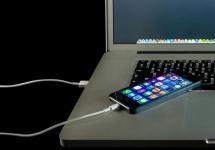According to statistics from 2015 taken from various sources, the number of people who have switched from Android to iOS in China and Europe is growing. In Russia, the situation is somewhat different.
The situation on the world market
In the first 3 months of 2015 in Germany, England, France, Italy and Spain, iPhone sales increased by almost 2%, compared to the same period of the previous year, the difference was 20.3%. According to analysts from Kantar Worldpanel, a third of users switched to iOS from Android smartphones. Research also suggests that the increase in popularity was due to the release of the iPhone 6 (as well as its improved versions 6S and 6S Plus).
In China, iPhone sales grew even more impressively compared to European countries: if in 2014 the number of users reached 17.9%, then in 2015 the percentage increased by 8.2% and reached 26.1%.
As for the United States, the number of iPhone users remains the highest in the world, standing at 36.5%.
Russian market
In Russia, the situation with the iPhone is completely different: unlike the countries of Europe, China and the USA, the percentage of new iPhone users is declining. If in 2014 the share of Apple smartphone sales was 11%, then in 2015 it decreased to 7%.
Analysts report that this situation in Russia is due to the fact that Russians prefer mobile gadgets costing less than 10 thousand rubles. Therefore, the first places in the platform rankings are occupied by Android and Windows.

Analysts' forecasts for 2016
Judging by the forecasts for 2016, in terms of sales it can break the records of 2015. Experts doom the new iPhone 6s and 6s Plus to success. It is predicted that the total number of devices sold worldwide in a year could reach 245 million units.
The Chinese market, as always, is expected to be the most accepting of Apple. Smartphones on the iOS platform have every chance to take first place among all manufacturers in the Middle Kingdom.
The main reason for Apple's popularity in 2015 is said to be almost absolute user satisfaction with the new iPhone 6s (99%, according to Tim Cook). Tamish Timson, an analyst at Kantar, states that 38 percent of iPhone users have shared their experience and recommended it to friends, which has also led to increased sales. Another reason for its popularity is the expansion of the range. The iPhone 5S has fallen in price and is now in the lower price segment, while the iPhone 6s Plus has quickly become an alternative to other large-screen smartphones.
However, the forecasts of some analysts are not so optimistic. In their opinion, difficult economic processes in the PRC, as the main consumer of Apple products, may affect a significant decrease in demand for this product. Moreover, Xiaomi and Meizu are advancing on all fronts, flagships that are not inferior in quality to devices from Apple, while the cost of Xiaomi and Meizu smartphones is more affordable.
In the fall, the company from Cupertino, in addition to new devices, released the first official version iOS 7, which caused a huge amount of controversy surrounding the complete redesign. It was at this time that users of Apple technology were divided into two camps, one of which had a positive attitude towards iOS 7, and the other denied the minimalism of the new firmware, so users preferred to stay on iOS 6. Of course, now there are no such disputes, while more and more owners of Apple equipment are switching to iOS 7. Analytical company Chitika I decided to conduct a study in which I calculated the approximate number of devices with the new firmware. For the first day after release iOS 7 About 18% of users in the US and Canada upgraded to it; by the end of the first week, this number increased to 52%. also notes that today the amount of traffic generated from devices running iOS 7, in North America is 70%. This means that approximately every third device supporting the new iOS, still hasn't been updated.

Device growth rate per iOS 7 overtake the previous one iOS 6 And Android Jelly Bean. On iOS 6 in the first month after release, only 63% of all devices were updated. According to statistics Chitika 74% new iPhone already running the new iOS, share iPad slightly less - only 64%, with 9% tablets iPad are still running iOS 5, which came out 2 years ago.

Analytical company Chitika was able to conduct this study by analyzing 300 million web page views by users in the United States and Canada. Of course, popularity iOS 7 is growing, and the number of users is increasing every day.
It is growing in China and Europe. In Russia, the situation is somewhat different.
The situation on the world market
In the first 3 months of 2015 in Germany, England, France, Italy and Spain, sales increased by almost 2%, compared to the same period of the previous year, the difference was 20.3%. According to analysts from Kantar Worldpanel, a third of users made the transition from Android smartphones. Research also states that the increase in popularity was due to the release (as well as its improved versions 6S and 6S Plus).

Analysts' forecasts for 2016
Judging by the forecasts for 2016, in terms of sales it can break the records of 2015. Experts doom the new iPhone 6s and 6s Plus to success. It is predicted that the total number of devices sold worldwide in a year could reach 245 million units.
The Chinese market is predicted to be the best received, as always. Smartphones on the iOS platform have every chance to take first place among all manufacturers in the Middle Kingdom.
The main reason for Apple's popularity in 2015 is said to be almost absolute user satisfaction with the new iPhone 6s (99%, according to Tim Cook). Tamish Timson, an analyst at Kantar, states that 38 percent of iPhone users have shared their experience and recommended it to friends, which has also led to increased sales. Another reason for its popularity is the expansion of the range. The iPhone 5S has fallen in price and is now in the lower price segment, while the iPhone 6s Plus has quickly become an alternative to other large-screen smartphones.
However, the forecasts of some analysts are not so optimistic. In their opinion, difficult economic processes in the PRC, as the main consumer of Apple products, may affect a significant decrease in demand for this product. Moreover, flagships that are not inferior in quality to devices from Apple are advancing on all fronts, while the cost of Xiaomi and Meizu smartphones is more affordable.
We made this conclusion based on summary statistics of the Liveinternet service on the RuNet. This interesting service allows you to find and analyze various information. Today we will calculate a few more interesting figures: how many Russians bought Apple equipment, what percentage of people in Russia use Android smartphones, and what is the share of mobile devices in general in relation to computers today.
So, here are summary statistics on the use of various devices to visit Runet sites for April 2015.
Liveinternet Statistics
It reflects the number of visits to sites where the LiveInternet counter is installed from various countries, so for calculations for Russia you need to know the share of the Russian audience. Here she is.
 Visitor count report
Visitor count report Using this data, we can roughly calculate many interesting numbers.
Interesting information about use Russians of the Internet
 OS Android
OS Android - The share of Russians among Runet visitors is 62%. For further calculations we will use direct proportion.
- To access the Internet Russians use 94 million different mobile and desktop devices(smartphones, tablets, laptops, desktop computers).
- The total share of mobile devices in everyday life is 53%, if laptops are classified as stationary equipment (there is no technical possibility to calculate the share of laptops).
- The share of Internet penetration in Russia in 2015 is still below 50%. It is impossible to give exact data; many users have access to the Internet from work, from their home PC, from their tablets and smartphones.
Now let's talk more about mobile technology.
Market share of iOS and Android in Russia for 2015
As of April 2015, Russians have bought and are using almost 10 million IPhones of various generations. To Apple's share in Russia you can add 3 million iPads and more than 850 thousand Mac computers. In total, about 14 million Apple devices have been sold in Russia.
There are 35 million Android smartphones and tablets in Russia.
Windows Phone - 1.2 million devices. This is less than the number of old smartphones running Symbian - there are still 2 million of them.
Let's repeat, We are talking only about equipment connected to the Internet. But today, most smartphones are connected to it. The exception is a decent proportion of pensioners, whose children and grandchildren buy modern equipment only for making phone calls. As a rule, the share of Apple mobile phone users among this category of the population is small; we can talk about an even larger share of Android.
According to available factual data, out of 51 million mobile devices connected to the Internet, the share of Apple equipment in Russia is about 25%, and smartphones and tablets of various brands running Android occupy 69% of the mobile device market.
The calculation may contain errors. For example, poorer Ukraine may actually have a lower share of iPhone users, making it marginally higher in Russia. In general, the data presented quite accurately reflect the state of affairs in the Russian mobile market in 2015.
Most studies that compare iOS And Android, often analyze the situation in the USA or Europe. It's time to look at the domestic market of mobile operating systems. For this purpose, portal specialists HeadHunter especially for website conducted a study, the data of which we invite you to get acquainted with. Below you can find unique and comprehensive information about which mobile operating system is more popular and in demand among domestic users.
A total of 1,521 people were interviewed during the study. The survey was conducted between December 9 and December 13, so the information is absolutely current. Let's get started.
Exactly 50% of respondents own Android smartphones. For iOS, the same figure is 24%. As for tablets, the leadership here also belongs to the mobile operating system from Google: 24% versus 18% from Apple’s development. A fifth of respondents, or 21%, do not own a single device based on the systems being compared.

Now let's see how actively respondents use their mobile devices at work. iPhone is the most popular work tool - 56% of its users use a smartphone for certain work-related tasks. Smartphones based on Android are also in high demand at work, but the share of such people is smaller – 51%. But tablets based on iOS and Android are used equally in work. In this case, 34% of people each answered in favor of both mobile operating systems.
The Russian market of “smart” devices is characterized by a trend in which employers do not strive to provide employees with corporate smartphones or tablets. In cases where this does happen, the choice falls on Apple devices. 5% of iPhones and 7% of iPads were purchased by employers. For Android, this figure is at 2% in both cases. In any case, the numbers are quite small. Most people who want to use a smartphone or tablet for work have to purchase the device themselves, with rare exceptions.
Then respondents were asked to choose 5 most common work situations when a mobile device helps them out. Very interesting results were obtained here. 91% of iPhone owners use their smartphone to communicate with colleagues. In this case, it is not telephone communications that are taken into account, but mail, various instant messengers and social networks. Android isn't far behind. For smartphones this figure reaches 88%, and for tablets 76%. iPads are used in a similar scenario by 83% of respondents.
Many respondents use iPhone and iPad as a task scheduler: 50% and 54%, respectively. At the same time, the Apple tablet is used more often than other devices for surfing the Internet and typing texts. No matter how manufacturers improve the cameras in tablets, smartphones are often used for photo and video shooting. Moreover, the share of iOS and Android in this case is almost identical. But tablets take their toll when accessing professional services and tools. It can also be noted that almost all of the devices under consideration are used by respondents as navigators, but smartphones based on Android are still somewhat more common. This probably affects the availability of navigation programs.
At the same time, it is interesting to know to what extent the users themselves happy with the use of iOS and Android at work. Most respondents believe that in both cases the devices still have room to grow. But Apple's development is still famous for its level of user satisfaction, which is reflected in the results of this study. iPhone is completely satisfied with 37% of its owners, and iPad – 38%. For Android, the figure is noticeably lower: only 28% are satisfied with their smartphone, and even fewer are completely satisfied tablet owners - 17%.
Of course, we cannot ignore the topic user migration between platforms. At the moment, the majority of respondents are completely satisfied with their devices and do not intend to move to the competitor’s camp. Satisfied iPhone and iPad users reached 69% each. In the case of Android, 62% of respondents are completely calm and do not think about changing their smartphone. But only 57% of respondents are satisfied with tablets with Google’s mobile operating system. But these are the ones who are happy with everything. Owners of Android devices are much more likely to think about changing their mobile platform: 19% of smartphone owners and 21% of tablet owners. For iPhone and iPad, the figures are significantly lower: 11% and 13%, respectively.
Finally, the authors of the study suggested the imminent appearance tablets with 12.9-inch display. We have already talked more than once about the work in the depths of Apple on a similar iPad. But how popular can such a device become in operation? Most are firmly convinced that no. About a quarter of respondents believe that you should first try working with such a device. Slightly less than a fifth of respondents are ready to switch to a giant tablet for work right now. It is clear that iOS users are noticeably more wary of increasing display sizes than Android users. Still, Apple managed to convince users that a large screen is not as convenient as it might seem from the outside.

These are the results of a study conducted by the HeadHunter portal specifically for the site. Still, the domestic struggle for mobile operating systems is developing according to the same scenario as throughout the world. Yes, we have some unique features, but they have little effect on the final result. Android is ahead in terms of the number of users, but in terms of ease of use and user loyalty, according to the study results, Google's development still lags behind its competitor, iOS.
Thanks to the head of the HeadHunter press service
Ivan Tyutyundzhi for coordination.
Please rate it.


